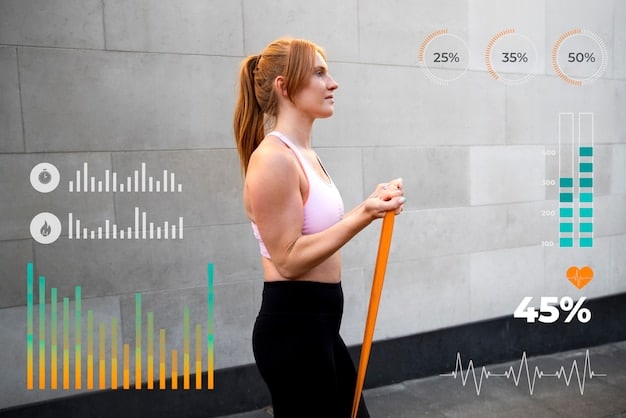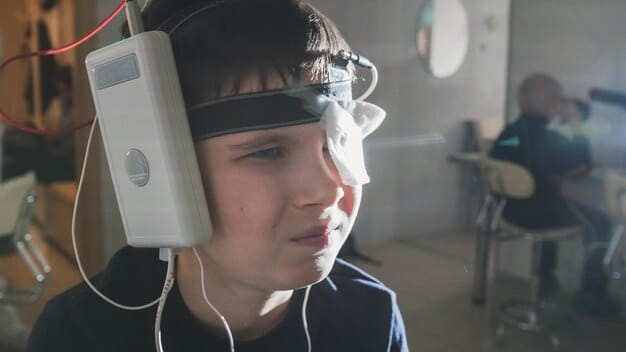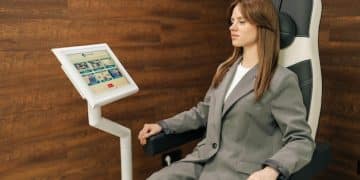Biofeedback for Anxiety: A Data-Driven Look at Its Effectiveness

Biofeedback training may help reduce anxiety by teaching individuals to become more aware of and control their physiological responses, potentially leading to decreased anxiety symptoms.
Can biofeedback training reduce anxiety? In today’s stressful world, many individuals are seeking non-pharmacological approaches to manage their anxiety. Biofeedback, a technique that empowers individuals to control bodily functions usually thought of as involuntary, has gained attention as a potential solution.
Understanding Biofeedback and Anxiety
Biofeedback is a technique that provides real-time feedback on physiological functions, such as heart rate, muscle tension, skin temperature, and brainwave activity. This feedback allows individuals to develop greater awareness and control over these functions, potentially alleviating symptoms of anxiety. Let’s delve into what biofeedback is and how it relates to anxiety.
What is Biofeedback?
Biofeedback uses sensors to monitor a patient’s physiological responses. This data is then displayed on a screen, allowing the individual to see how their body reacts to different stimuli or thoughts. The goal is to learn how to consciously influence these responses, promoting relaxation and reducing stress.
The Link Between Biofeedback and Anxiety
Anxiety often manifests as heightened physiological arousal, including increased heart rate, muscle tension, and rapid breathing. By using biofeedback, individuals can learn to regulate these responses, thereby reducing the physical symptoms of anxiety and promoting a sense of calm.
- Enhances self-awareness of physiological responses.
- Teaches techniques for conscious control over bodily functions.
- Promotes relaxation and reduces physical symptoms of anxiety.
In essence, biofeedback provides a toolset for individuals to actively manage their anxiety symptoms by understanding and controlling their body’s responses. Through consistent practice, individuals can develop the skills necessary to reduce anxiety levels in various situations.
The Science Behind Biofeedback and Anxiety Reduction
Numerous studies have explored the effectiveness of biofeedback training in reducing anxiety. These studies often focus on different types of biofeedback and various anxiety disorders. Let’s examine some of the key findings and research supporting the use of biofeedback for anxiety.
Overview of Relevant Studies
Research has indicated that biofeedback can be an effective treatment for various anxiety disorders including generalized anxiety disorder (GAD), social anxiety disorder (SAD), and panic disorder. These studies often measure anxiety levels through self-report questionnaires and physiological measures.
Specific Types of Biofeedback Studied
Different types of biofeedback, such as heart rate variability (HRV) biofeedback, electromyography (EMG) biofeedback (which measures muscle tension), and neurofeedback (which monitors brainwave activity), have been studied for their effects on anxiety. Each type targets different physiological mechanisms associated with anxiety.

- HRV biofeedback focuses on improving the balance between the sympathetic and parasympathetic nervous systems.
- EMG biofeedback aims to reduce muscle tension, a common symptom of anxiety.
- Neurofeedback seeks to regulate brainwave patterns associated with anxiety.
The collective evidence suggests that biofeedback can be a valuable tool in managing and reducing anxiety symptoms. However, the effectiveness may vary depending on the type of biofeedback used and the specific needs of the individual.
Types of Biofeedback Training for Anxiety
Biofeedback training isn’t a one-size-fits-all approach. Different types of biofeedback target different physiological responses. Understanding the various types can help individuals choose the most appropriate option for their specific needs. Let’s explore some of the most common types of biofeedback used for anxiety reduction.
Heart Rate Variability (HRV) Biofeedback
HRV biofeedback focuses on increasing the variability in heart rate, which is associated with better emotional regulation and resilience to stress. By training individuals to consciously influence their heart rate patterns, HRV biofeedback can promote a sense of calm and reduce anxiety.
Electromyography (EMG) Biofeedback
EMG biofeedback measures muscle tension, allowing individuals to identify and release areas of tension in their body. This type of biofeedback is particularly helpful for individuals who experience muscle stiffness or pain as a result of anxiety.
- HRV biofeedback improves heart rate variability and emotional regulation.
- EMG biofeedback reduces muscle tension and promotes relaxation.
- Neurofeedback regulates brainwave patterns associated with anxiety.
Ultimately, the choice of biofeedback type depends on the individual’s specific symptoms and preferences. Consulting with a qualified biofeedback therapist can help determine the most suitable approach.
How Biofeedback Training Works: A Step-by-Step Guide
Understanding the biofeedback process can demystify the technique and empower individuals to engage in it effectively. The process typically involves several steps, from initial assessment to ongoing practice. Let’s break down the steps involved in biofeedback training.
Initial Assessment and Goal Setting
The first step in biofeedback training is an initial assessment by a qualified therapist. This assessment helps identify the individual’s specific anxiety symptoms and physiological responses that can be targeted with biofeedback. Goals are then established to track progress.
The Biofeedback Session
During a biofeedback session, sensors are attached to the individual’s body to monitor physiological functions such as heart rate, muscle tension, or brainwave activity. This information is displayed on a computer screen, providing real-time feedback.

- Sensors are attached to monitor physiological functions.
- Real-time feedback is displayed on a computer screen.
- Individuals learn techniques to consciously control their responses.
Biofeedback training is an active process that requires commitment and practice. By following these steps, individuals can learn to effectively manage their anxiety symptoms and improve their overall well-being
Benefits and Limitations of Biofeedback for Anxiety
Like any treatment approach, biofeedback has its own set of benefits and limitations. Understanding these aspects can help individuals make informed decisions about whether biofeedback is right for them. Let’s explore the advantages and disadvantages of using biofeedback for anxiety.
Potential Benefits of Biofeedback
One of the primary benefits of biofeedback is its non-invasive nature. It doesn’t involve medication and has minimal side effects. Additionally, biofeedback can empower individuals to take an active role in managing their anxiety.
Limitations and Considerations
Despite its benefits, biofeedback may not be suitable for everyone. It requires commitment and consistent practice to be effective. Also, access to qualified biofeedback therapists can be a limiting factor in some areas.
- Non-invasive and minimal side effects.
- Empowers individuals to actively manage their anxiety.
- Requires commitment and consistent practice.
Overall, biofeedback can be a valuable tool for anxiety management, but it’s important to consider both its benefits and limitations before starting treatment. A thorough assessment can determine if biofeedback is a suitable option.
Integrating Biofeedback with Other Anxiety Treatments
Biofeedback can be used as a standalone treatment for anxiety, but it can also be integrated with other therapeutic approaches for enhanced effectiveness. Combining biofeedback with traditional therapies can provide a more comprehensive approach to anxiety management. Let’s examine how biofeedback can be integrated with other treatments.
Combining Biofeedback with Cognitive Behavioral Therapy (CBT)
CBT is a popular and effective therapy for anxiety. When combined with biofeedback, it can help individuals identify and change negative thought patterns while also learning to control physiological responses to anxiety-provoking situations.
Lifestyle Changes to Support Biofeedback
In addition to therapy, lifestyle changes such as regular exercise, a healthy diet, and mindfulness practices can complement biofeedback training. These changes can enhance the overall effectiveness of biofeedback in reducing anxiety.
- CBT helps address negative thought patterns.
- Lifestyle changes complement biofeedback training.
- Medication can be combined under medical supervision.
By integrating biofeedback with other treatments and lifestyle changes, individuals can create a comprehensive and personalized approach to managing their anxiety. This holistic approach can lead to more sustainable and lasting results.
| Key Point | Brief Description |
|---|---|
| 🧠 Understanding Biofeedback | Learn how biofeedback helps manage anxiety through awareness of physiological responses. |
| 📊 Scientific Evidence | Studies show biofeedback is effective in reducing anxiety symptoms across different disorders. |
| 💪 Types & Techniques | HRV, EMG, and neurofeedback are common types, each targeting specific physiological responses. |
| ✅ Integration | Combining biofeedback with CBT, lifestyle changes, or medication can enhance results. |
FAQ
▼
Biofeedback is a technique that provides real-time feedback on physiological functions like heart rate and muscle tension, helping individuals learn to control these responses and reduce anxiety.
▼
The effectiveness varies; HRV biofeedback can improve emotional regulation, while EMG biofeedback helps reduce muscle tension, both beneficial for managing anxiety symptoms.
▼
Results vary among individuals, but many people experience noticeable improvements within a few weeks of consistent biofeedback training and regular practice.
▼
Biofeedback is generally considered safe with minimal side effects. Some individuals might experience mild fatigue or discomfort, but these are typically temporary and rare.
▼
Yes, biofeedback can be used alongside medication. In fact, it can potentially reduce the need for medication over time under medical supervision and can enhance the treatment effectiveness.
Conclusion
In conclusion, biofeedback training offers a promising avenue for individuals seeking to manage and reduce anxiety. With its non-invasive nature and focus on empowering individuals, it stands as a valuable tool, especially when integrated with other therapeutic approaches and lifestyle changes, towards achieving sustainable well-being.





